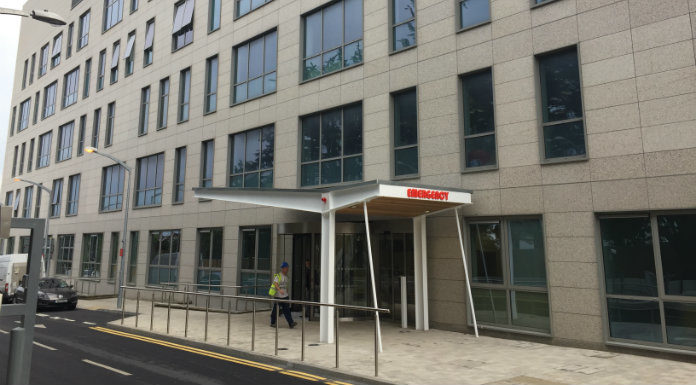The UL Hospitals Group says there’s currently no evidence to suggest an outbreak of Covid-19 at the region’s main hospital is connected to overcrowding.
It follows concerns from the Irish Nurses Organisation, which has called for Ministerial intervention in light of high trolley numbers there, despite the introduction of an additional 100 new beds.
The latest figures from the HSE show there were 16 patients being treated for Covid-19 at University Hospital Limerick last night, down two on the previous day, with 13 suspected cases, a drop of 4 in 24 hours.
It follows an outbreak of the virus at the Dooradoyle facility, which led to a visiting ban being reintroduced late last week, just ten days after restrictions were eased there.
The INMO claims high trolley numbers are impacting “hugely” on the spread of the virus and has criticised the levels of overcrowding, particularly in light of the introduction of more than 100 new beds.
But the UL Hospitals Group says there is no evidence to suggest a link between overcrowding and the outbreak.
In a statement to Clare FM, hospital management say they’re following all national guidance in respect of the management of Covid-19 and that every effort is being made to comply with social distancing in the ED.
But they say that because of the volume of presentations and admissions, this has been difficult to achieve at times.
They also say that in delivering care in ED, they need to balance infection prevention and control precautions against promptly assessing and treating patients in line with their clinical need.
The UL Hospitals Group does admit, however, that it is correct in general that overcrowding in healthcare environments represent an increased infection risk.
They go on to say that the two wards currently affected by the outbreak are older ward infrastructure which has been a feature of hospital outbreaks in UHL and elsewhere throughout the pandemic, as noted by HIQA this week.
Full Statement from the UL Hospitals Group
The Emergency Department at University Hospital Limerick remains exceptionally busy. Sustained high volumes of attendances, including many frail elderly patients with complex medical conditions, have continued over several weeks now.
On Tuesday August 3rd, there were 259 attendances at ED, followed by 249 on Wednesday, 266 on Thursday and 249 on Friday. This compares to 195 daily attendances during 2019, the last full-year pre-pandemic. On Saturday, there were 173 ED attendances and 177 on Sunday, and these figures again exceed average weekend attendances pre-pandemic. On Monday of this week there were 255 ED attendances.
Increased demand on acute hospital services due to the current record levels of emergency presentations around the country is putting staff of all grades under considerable pressure.
At 8pm this Tuesday there were 13 admitted patients on corridors in the Emergency Department. We regret that any patient has to wait for a bed and every effort is being made by management and staff to reduce these wait times and to maximise patient flow.
We continue to follow our escalation plan, which includes additional ward rounds, accelerating discharges and identifying patients for transfer to our Model 2 hospitals. However, current demand for our services is multi-faceted and high numbers of admitted patients require a level of care that, for the Mid-West, can only be provided at UHL. We note also that the number of COVID-positive patients in UHL has increased over recent weeks and stood at 17 this Tuesday.
Covid-19 Guidance and Current Outbreak
We are following all the national guidance in respect of the management of Covid-19. At the point of presentation to ED, patients presenting for assessment are segregated into ‘possible COVID’ and ‘COVID not suspected’ parallel streams.
Stable medical and surgical patients in the non-Covid stream are directed to the Medical Assessment Unit and Surgical Assessment Unit, which since March 2020 have been operating as medical and surgical EDs. Patients with a confirmed or suspected Covid infection are isolated or cohorted in the ED.
Every effort is made to comply with social distancing in the ED but such has been the volume of emergency presentations and admissions in recent weeks that this has been at times difficult to achieve. In delivering care in ED, we need to balance infection prevention and control precautions against promptly assessing and treating patients in line with their clinical need.
In respect of the current Covid-19 outbreak at UHL, two inpatient wards are affected although visiting restrictions are in place on all inpatient wards. Contact tracing continues in respect of the outbreak but there is no evidence to date that the it is connected with Emergency Department crowding. However it is correct in general that overcrowding in healthcare environments represent an increased infection risk. The wards currently affected are nightingale wards and this older ward infrastructure has been a feature of hospital outbreaks in UHL and elsewhere throughout the pandemic, as noted in the overview published by HIQA this week.
Bed Capacity
In relation to the additional beds opened at UHL, it should be noted that much of this bed stock has been designated for our most vulnerable patients; the 24-bed single block for cancer patients and the 60-bed block, according to the trajectory of the pandemic, has been used to isolate patients including Covid-19 patients who are very ill and often require non-invasive ventilation at ward level.
The additional beds at UHL have been invaluable in protecting patients against Covid-19 but, as we have at all times stated, only go some of the way towards addressing the widely acknowledged deficit in bed capacity in the MidWest. This has been compounded by the sustained increase in attendances seen in hospitals across the country over the last several weeks.
Planning permission was granted for the 96-bed ward block at UHL at the end of February 2021, and the HSE Capital Plan for 2021 provides funding for the detailed design work for the project to be progressed. The new four-storey building, will be located over the hospital’s current Emergency Department and, subject to approval, will take a number of years to complete.
Staffing Levels and ED Deficits
We wish to acknowledge the exceptional work of our nursing, and indeed all, staff during the pandemic.
As of the end of July 2021, there were 1120 whole-time equivalent nursing staff in UHL with 31.85 WTE true vacancies and 83.56 temporary deficits (including staff on various types of leave and vulnerable staff). In the year to date, we have hired 238.04 WTE staff nurses at UHL.
A total of 28.5 WTE staff nurses have been recruited to the ED in the year to date. There are a total of 119.36 WTE in ED with a total of 17.08 vacancies (5.9 true vacancies and 11.09 temporary vacancies).
Current nursing deficits in UHL are at relatively low levels while we still continue to recruit newly funded positions and expand the overall nursing workforce, including in ED.









